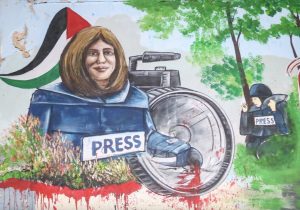London – Press freedom watchdogs were right, expressing their disbelief at the extension of the prisoner amnesty announced in Myanmar at the end of November: In December alone, five journalists were sentenced to prison in the country led by the military junta that seized power. in February 2021.
The most recent victim is self-employed Soe Yarzar Tun, who was sentenced to four years in prison by a special court at Insein prison in Yangon on December 16.
According to a survey conducted by the NGO Reporters Without Borders, based on data from the Association for Assistance to Political Prisoners (AAPP), the penalty under Article 52(a) of the Anti-Terror Law includes forced labor.
The special court also sentenced two journalists from the Thingangyun Post news site, deputy editor Htet Htet Aung and editor-in-chief Wai Linn Yu, to five years in prison under Section 5 of the Explosives Act. They were allegedly “caught with explosives” when they were arrested on November 11, 2021.
Before them, journalists Sithu Aung Myint and Myo San So were sentenced to 12 and 15 years in prison, respectively, in early December and late November.
In the November pardon that restored freedom, 5,774 people were arrested, several journalists were released. one of them Japanese documentary filmmaker Toru Kubota, who is serving a 10-year sentence for rioting, illegal immigration and other charges.
The numbers released range from five to eight. At the same time, new convictions show that press freedom is deteriorating in Myanmar.
“Burmese generals are deepening their policy of terrorism by keeping journalists at the forefront of the missing,” said Daniel Bastard, Asia-Pacific chief of Reporters Without Borders.
Arrest due to ‘false information’ about government officials in Myanmar
First arrested on 28 February 2021 while following street protests against the military coup, Soe Yarzar Tun was held in Insein Prison until 30 June 2021 under Section 505(a) of the Penal Code (which punishes misinformation about government officials). took advantage of it.
He was recaptured on March 10, 2022, in the town of Thonse, 70km north of Yangon, a few days after fleeing a military attack on his monastery.
According to Reporters Without Borders, his case illustrates the judicial persecution of media workers by the military junta.
Ranked 176 out of 180 countries in RSF’s 2022 World Press Freedom Index, Myanmar currently has at least 62 journalists incarcerated, making it the second most imprisoned country for media professionals in the world (second only to China) .
CPJ: 42 journalists arrested in country
The Committee to Protect Journalists (CPJ) number is lower, but no less alarming: On December 1, the organization’s balance sheet had 42 people in prison, 40% higher than recorded in the same month in 2021.
Press freedom organizations are adopting different methodologies to explain violations, such as verifying work attribution and involving media support professionals.
Also read | 2022 is the year when the number of journalists arrested broke a record in the world.
CPJ lists Myanmar as the third most imprisoned country for journalists, after Iran and China.
According to the organization, about half of the detainees were convicted in 2022, and most were sentenced under Section 505(a) of the Penal Code, an anti-state provision that broadly punishes “incitement” and “false news”.
The NGO points out that it is ill-defined in its formulation of legal provisions and has been arbitrarily interpreted to justify the two- and three-year prison sentences imposed on journalists by military-influenced courts in Myanmar.
Others received longer charges of terrorism and other anti-state charges, often for communicating with armed resistance groups against the military or reporting on their activities, including PDFs that the newly formed “people’s defense forces” or the junta deem to be terrorist organisations. . as well as decades of ethnic armies fighting for autonomy and rights.” By Shawn Crispin, CPJ Southeast Asia representative, in an article analyzing the situation in the country.
But he warns that the number could be much higher:
“Many media outlets are reluctant to identify prison staff and self-employed journalists, especially in order to avoid the harsh penalties imposed on journalists who go undercover in vehicles prohibited by the military or who claim to have stopped working but continue to report undercover.” .
Crispin, a journalist living in Thailand, said that the selective release of journalists, which was shown as amnesty, while others were forced to serve full sentences in harsh prison conditions, was intended to hide the real number of journalists that the junta caught. and sow division between independent media groups.
“The independent media has been targeted since the first day of the coup. “It’s like they’ve put together a list of editors and reporters to go after,” said Aung Zaw, founder and editor-in-chief of the independent The Irrawaddy, which Shawn Crispin heard.
“Some have been released [enquanto] “Some of them were accused of treason, terrorism and electronic crimes, allegations that make no sense.”
Zaw is a former recipient of CPJ’s International Press Freedom Award. Noting that the regime is seeking to “divide and rule” independent media, some news organizations post “ad” and “echo” What does the regime say?
In September, 33 independent media released a statement denouncing a new press council established since the coup, accusing them of “spreading disinformation” and “propaganda messages” about Myanmar’s independent media.
According to the document, 140 journalists have been arrested since the military came to power and the licenses of 11 media groups have been revoked.
“The military council is suppressing independent media groups and journalists in Myanmar in many different ways, hindering the right to information and freedom of press and expression across the country.”
Many of the signatories are among the media outlets that keep journalists behind bars or arrest and release professionals.
Also read | The International Federation of Journalists says the world is losing a media professional every five days in 2022
source: Noticias
Mark Jones is a world traveler and journalist for News Rebeat. With a curious mind and a love of adventure, Mark brings a unique perspective to the latest global events and provides in-depth and thought-provoking coverage of the world at large.

